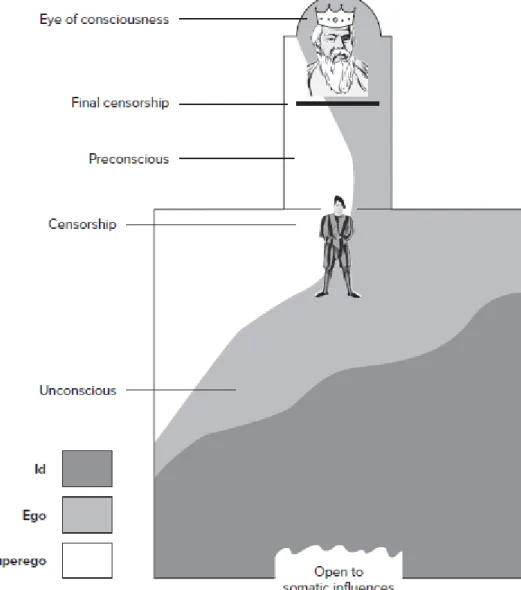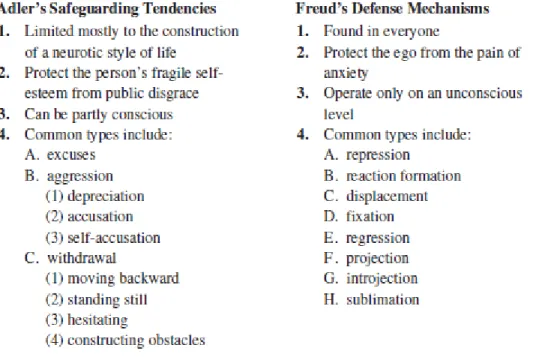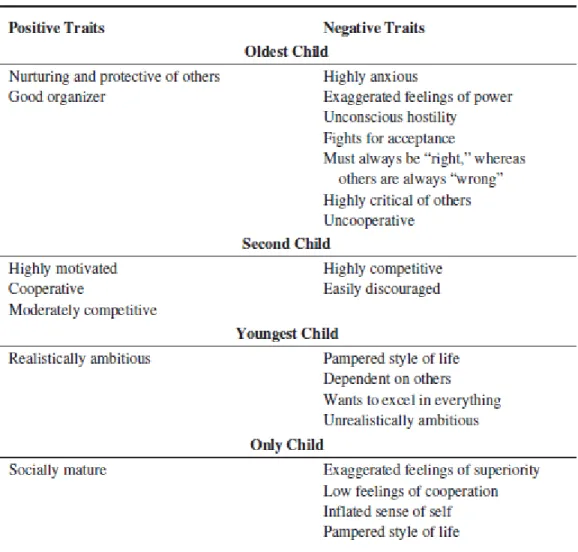Mary of the Plains and degrees from Wichita State University and the University of Kansas. His last book, The Psychology of Science and the Origins of the Scientific Mind, was awarded the William James Book Award by American.
Preface
Page xvii Thus, the various theories discussed in these pages reflect the unique cultural backgrounds, family experiences, and professional training of their originators. Therefore, we evaluate each of the theories discussed in this book based on these four criteria, but also on (5) its internal consistency and (6) its simplicity.
The Ninth Edition
The current edition continues to provide comprehensive coverage of the most influential personality theorists. Because each theory is an expression of its creator's unique view of the world and humanity, we include ample biographical information on each theorist so that readers have the opportunity to become familiar with both the theory and the theorist.
What’s New?
A complete test bank of multiple choice questions that test students on key concepts and ideas in each chapter. An instructor's manual for each chapter with full chapter summaries, sample questions, and discussion topics.
Acknowledgments
PA RT ONE
Introduction
CHA PTER 1
Introduction to Personality Theory
For centuries, philosophers, theologians, and other thinkers have asked these questions as they pondered the nature of human nature—or even. However, more than a hundred years ago, Sigmund Freud began to combine philosophical speculation with a primitive scientific method.
What Is Personality?
Most agree that the word "persona" comes from the Latin persona, which refers to the theatrical mask worn by Roman actors in Greek dramas. Few personality theorists have formally defined personality, but they all have their own take on it.
What Is a Theory?
Some were born in Europe and lived there all their lives; others were born in Europe but immigrated to other parts of the world, especially the United States; still others were born in North America and remained there. Traits are unique qualities of an individual that include attributes such as temperament, physique, and intelligence.
Theory Defined
A scientific theory is a set of related assumptions that enable scientists to use logical deductive reasoning to formulate testable hypotheses. The components of a theory are not proven facts in the sense that their validity is absolutely established.
Theory and Its Relatives
The theory deals with large sets of if-then statements, but the goodness or badness of the results of these statements is beyond the realm of the theory. A theory is too general to be subject to direct verification, but a single overarching theory is capable of generating thousands of hypotheses.
Why Different Theories?
Perspectives in Theories of Personality
Beginning with Freud, psychoanalytic and then more general psychodynamic approaches focused on the importance of the early. To understand behavior, focus only on behavior, not on hypothetical and unobservable internal states such as thoughts, feelings, instincts, or motives.
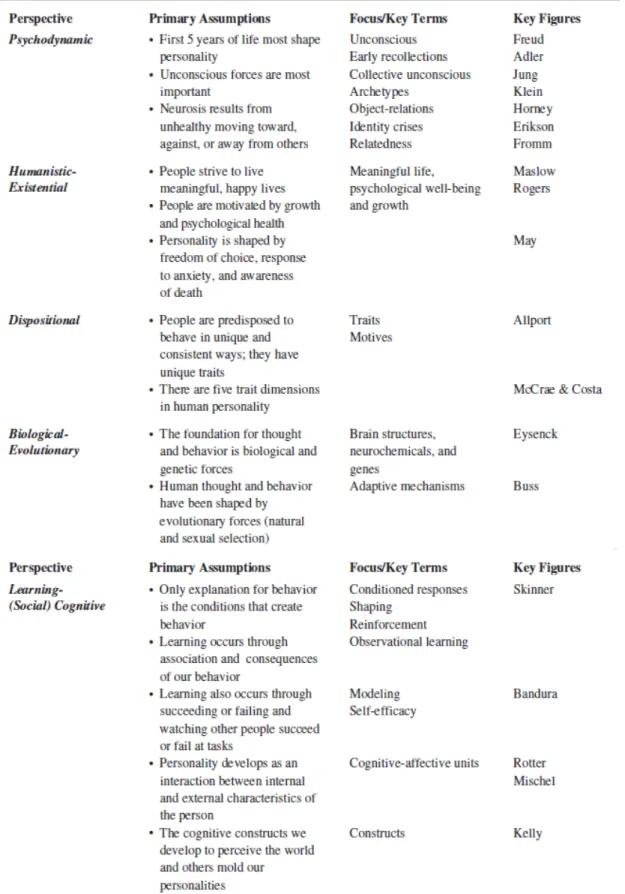
Theorists’ Personalities and Their Theories of Personality
Although a theorist's personality partly shapes his or her theory, it should not be the sole determinant of that theory. Thus, your evaluation of any of the theories presented in this book should rest more on objective criteria than on your subjective likes and dislikes.
What Makes a Theory Useful?
Therefore, we have evaluated each of the theories presented in this book on the basis of six criteria: A useful theory (1) generates research,. The most important criterion of a useful theory is its ability to stimulate and direct further research.
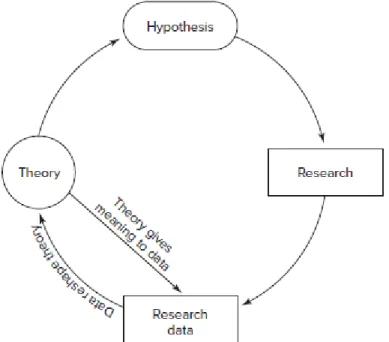
Dimensions for a Concept of Humanity
An operational definition is one that defines units in terms of observable events or behaviors that can be measured. However, these differences do not negate the possibility that two theorists with opposing views of humanity can be equally scientific in their data collection and theory building.
Research in Personality Theory
Validity is the extent to which an instrument measures what it is intended to measure. The term "personality" comes from the Latin persona, or the mask that people present to the outside world, but psychologists see personality as much more than outward appearances.
Psychodynamic Theories
CHA PTER 2
Freud: Psychoanalysis
The young doctor wrote a pamphlet extolling the benefits of the drug, but he had not yet completed the necessary experiments on the drug's value as a pain reliever. These events took place in 1884; the drug was cocaine; the young doctor was Sigmund Freud.
Overview of Psychoanalytic Theory
After learning about the successful use of the drug in heart disease, nervous exhaustion, alcohol and morphine addiction and many others. For him, the medicine had a pleasant smell and an unusual effect on the lips and mouth.
Biography of Sigmund Freud
Third, Freud's brilliant command of language enabled him to present his theories in a stimulating and exciting manner. Freud's understanding of human personality was based on his experiences with patients, his analysis of his own dreams, and his vast readings in the various sciences and humanities.
Levels of Mental Life
Moreover, during his journey to the United States he had several experiences that were strange for a true bourgeois Viennese gentleman. Also in the camp, Freud, along with the others, sat on the floor while the host grilled steaks over charcoal, a practice that Freud considered both savage and ill-mannered (Roazen, 1993).
Unconscious
The unconscious of the first person. however, has directly influenced the unconscious of the second. Thus, the unconscious mind of one person can communicate with the unconscious mind of another without either person being aware of the process.
Preconscious
Conscious
Once in the preconscious, they avoid a final sensor and come under the eye of consciousness. People in the reception room (preconsciously) may or may not come into view of the important guest which of course represents the eye of consciousness.
Provinces of the Mind
The Id
The Ego
As children begin to experience parental rewards and punishments, they learn what to do to achieve pleasure and avoid pain. As children reach age 5 or 6, they identify with their parents and begin to learn what they should and shouldn't do.
The Superego
The second person, with strong feelings of guilt or inferiority and a weak ego, will experience many conflicts because the ego cannot arbitrate the strong but conflicting demands of the superego and id. The third person, with a strong ego that has incorporated many of the demands of both the id and the superego, is psychologically healthy and controls the pleasure principle and the moral principle.
Dynamics of Personality
Drives
The goal of the sexual drive is pleasure, but this pleasure is not limited to genital satisfaction. The final goal of the sexual drive (reduction of sexual tension) cannot be changed, but the path by which the goal is reached can be varied.
Anxiety
They often create anxiety, which refers many sexual and aggressive desires to the unconscious area. After children establish a superego—usually by age 5 or 6—they may experience anxiety as an outgrowth of the conflict between realistic needs and their superego.
Defense Mechanisms
Fear is also self-regulating because it produces repression, which in turn reduces the pain of fear (Freud). Defensive behavior therefore serves a useful function by protecting the ego from the pain of fear.
Repression
A third and far more common fate of repressed drives is that they are expressed in displaced or disguised forms. Repressed drives can also find an outlet in dreams, slips of the tongue, or one of the other defenses.
Reaction Formation
Displacement
Fixation
Regression
Projection
Instead of saying, "I love him," the paranoid person says, "I hate him." Because it also causes too much anxiety, he says, "He hates me." At this point the person has
Introjection
Sublimation
Stages of Development
Infantile Period
However, the female Oedipus complex is usually broken down more slowly and less completely than the male's. Second, penis envy precedes the female Oedipus complex, while the opposite is true for boys; that is, the castration anxiety follows the male Oedipus complex.
Latency Period
But we need not be ashamed of this distinction; after all, the sex life of adult women is a. The sex drive during latency still exists, of course, but its goal has been thwarted.
Genital Period
Thus, the prohibition of sexual activity is part of our phylogenetic endowment and does not need personal experiences of punishment for sexual activities to suppress sexual desire. During this time, children form groups or cliques, something that was impossible during the infantile period when sexual desire was entirely autoerotic.
Maturity
This synthesis of Eros, the elevated status of the vagina, the reproductive capacity of the sexual drive, and the ability of humans to direct their libido outward rather than toward the self, represents the most important distinction between infantile and adult sexuality. Indeed, most of the repressions of psychologically healthy individuals would emerge in the form of sublimations rather than neurotic symptoms.
Applications of Psychoanalytic Theory
Because the Oedipus complex of mature people is completely or almost completely dissolved, their libido, which was previously directed towards parents, would be released to search for both tender and sensual love.
Freud’s Early Therapeutic Technique
In fact, such a highly suggestive procedure would very likely produce the precise results Freud needed, namely the confession of a childhood seduction. Furthermore, while using both dream interpretation and hypnosis, Freud told his patients to expect scenes of childhood sexual experiences to emerge (Freud.
Freud’s Later Therapeutic Technique
Transference feelings are not earned by the therapist and are only transferred to her from the patients' previous experiences, usually with their parents. Positive transference allows patients to more or less relive childhood experiences in the non-threatening climate of analytic treatment.
Dream Analysis
Dreams of the death of a loved one also arise in childhood and are wish fulfillment. With each of these three typical dreams, Freud had to search for the wish behind the manifest level of the dream.
Freudian Slips
Dreamwork achieves its goal through processes of thickening, displacement and inhibition of affect. Manifest dreams may bear little resemblance to latent material, but Freud believed that careful interpretation would reveal the hidden connection by tracing the dream work backwards until the unconscious images were revealed.
Related Research
This conclusion is entirely consistent with Freud's metaphor that consciousness is merely the "tip of the iceberg." Ramachandran, publicly declared the value of Freud's theory, claiming that "psychoanalysis is still the most coherent and intellectually satisfying view of the mind" (as cited in Solms, 2004, p. 84).
Unconscious Mental Processing
We have reviewed some of the empirical evidence for unconscious mental processing, the id and the pleasure principle, and the ego and the reality principle.
Pleasure and the Id, Inhibition and the Ego
This work pinpointed two important neurotransmitters involved in the id's constant pursuit of pleasure: dopamine and opioids (such as endorphins). All this, according to Solms, supports Freud's ideas about the pleasure principle of the id and the reality principle of the ego.
Repression, Inhibition, and Defense Mechanisms
During these operations, a procedure was performed in which electrodes stimulated parts of the motor cortex, and the time it took for the stimulus to be consciously perceived was recorded. Neither age nor IQ is related to the time it takes for the stimulus to be perceived.
Research on Dreams
Expression participants were told to think about one or the other target person for five minutes. Then, for the next five minutes, they were told to think about anything but the intrusive thought.
Critique of Freud
These researchers suggest that relaxation and letting go of suppressing thoughts is one way to reduce the occurrence of nightmares. The benefits of talking about one's dreams may have little to do with the specific content (latent or overt) but simply with speaking out loud about troubling cognitions and therefore bypassing active thought suppression that may life promoting the return of dreams in the first place.
Did Freud Understand Women, Gender, and Sexuality?
Freud's female colleagues and disciples were selected for their intelligence, emotional strength, and loyalty—the same qualities Freud found attractive in men. In two of Freud's works, Mourning and Melancholia (1917) and The Ego and the Id (1923), he argued that part of the process of forming our character (our ego) is first the mourning and then the substitution of lost. love objects with other objects.
Was Freud a Scientist?
This kind of reasoning clearly gives Freudian theory a very low rating on its ability to generate falsifiable hypotheses. A third criterion of any useful theory is its ability to organize knowledge into a meaningful framework.
Concept of Humanity
Worse, we are usually not aware of the reasons for our behavior and are not. Freud believed that everything from slips of the tongue to religious experiences are the result of a.
CHA PTER 3
Adler: Individual Psychology
When Maslow casually asked the older man about being a follower of Freud, the older man became very angry and, according to Maslow, nearly shouted at him. Whenever reporters and other people would ask about his early relationship with Freud, Adler would produce the faded old postcard with Freud's invitation to Adler to join Freud and three other doctors in meeting at the house of Freud on Thursday evening.
Overview of Individual Psychology
Biography of Alfred Adler
Adler's poor health was in sharp contrast to the health of his older brother Sigmund. However, Adler soon changed the name of his organization to the Society for Individual Psychology - a name that clearly indicated that he had abandoned psychoanalysis.
Introduction to Adlerian Theory
His personal characteristics included an optimistic attitude towards the human condition, an intense competitiveness combined with friendly friendliness and a strong belief in the fundamental equality of the sexes, which combined with a willingness to vigorously defend the rights of women. Then, in the early months of 1937, while worrying about the fate of his daughter Vali, who had disappeared somewhere in Moscow, Adler felt chest pains while on a speaking tour in Holland.
Striving for Success or Superiority
The value of all human activities must be seen from the point of view of social interest. In his final theory, however, he limited the striving for multivalue to those people who strive for personal superiority over others and introduced the term striving for success to describe the actions of people motivated by a highly developed social interest (Adler, 1956).
The Final Goal
Regardless of the motivation for each individual's endeavor, the end goal guides. strong and attachment to it has become a natural means of achieving multiple values. From the point of view of the end goal, however, they get caught in a self-consistent pattern. 1956) used the analogy of a dramatist building the features and subplots of a play according to the ultimate goal of the play.
The Striving Force as Compensation
It is not necessarily a mirror image of scarcity, although it is a substitute for it. Natural and nurturing forces can never rob a person of the power to set a unique goal or choose a unique style of goal achievement (Adler, 1956).
Striving for Personal Superiority
Around age 4 or 5, children begin this process by setting a direction for the striving force and setting a goal of personal superiority or of social success. Although the creative force is influenced by the forces of heredity and environment, it is ultimately responsible for the personality of people.
Striving for Success
To a casual observer it may appear that he is motivated by social interests, but his actions are largely self-interested and motivated by overcompensation for his exaggerated feelings of personal superiority.
Subjective Perceptions
Fictionalism
Vaihinger believed that fictions are ideas that have no real existence, yet they affect people as if they really existed. A second example might be: "People have a free will that enables them to make choices." Again, many people act as if they and others have free will and are thus responsible for their choices.
Physical Inferiorities
Although this idea is a fiction, many people, both men and women, act as if it is a reality. Nevertheless, they give purpose to all people's actions and are responsible for a consistent pattern that runs throughout their lives.
Unity and Self-Consistency of Personality
Adler emphasized that physical deficiencies alone do not cause a particular lifestyle; they simply provide current motivation for achieving future goals.
Organ Dialect
Conscious and Unconscious
Conscious life becomes unconscious as soon as we do not understand it - and as soon as we understand an unconscious tendency, it has already become conscious.
Social Interest
Whether people's behavior leads to a healthy or an unhealthy lifestyle depends on the degree of social interest that they developed in their childhood years. Both mother and father can contribute strongly to their children's social interest.
Origins of Social Interest
The ideal father cooperates equally with the child's mother in caring for the child and treating him as a human being. Adler believed that after the age of 5, the effects of heredity become obscured by the powerful influence of the child's social environment.
Importance of Social Interest
Exaggerated feelings of inferiority lead to a neurotic lifestyle, while normal feelings of incompleteness result in a healthy lifestyle. Whether a person leads a useless or socially useful lifestyle depends on how he views these inevitable feelings of inferiority.
Style of Life
They actively struggle to solve what Adler considered the three main problems of life—love of neighbor, sexual love, and vocation—and they do so through cooperation, personal courage, and a willingness to contribute to the welfare of others. Adler (1956) believed that people with a socially useful way of life represent the highest form of humanity in the evolutionary process and probably that.
Creative Power
This is how the psychologically healthy individual solves most of life's problems. As you approach the low doorway, you are neither forced to stoop nor forced to bump your head.
Abnormal Development
We are not forced to grow in the direction of social interest, as we do not have an inner nature that compels us to be good. We are who we are because of the use of our bricks and mortar.
General Description
Adler used an interesting analogy, which he called “the law of the low doorway.” If you're trying to walk through a five-foot doorway, you have two basic choices. Their view of the world does not correspond to that of other individuals and they possess what Adler (1956) called “private meaning” (p. 156).
External Factors in Maladjustment
They feel as if they are living in an enemy country, they fear defeat more than they want success, and they are convinced that the main problems of life can only be solved in a selfish way (Adler, 1927). They are distrustful of other people and are unable to work together for the common good.
Safeguarding Tendencies
Adler (1956) argued that some people use aggression to safeguard their exaggerated superiority complex, that is, to protect their fragile self-esteem. Although hesitation may seem self-defeating to other people, it allows neurotic individuals to maintain their inflated sense of self-worth.
Masculine Protest
These opposing views of femininity were magnified in the women Freud and Adler chose to marry. Alfred became more capitalist and advocated personal responsibility, while Raissa became involved in the dangerous communist politics of her native Russia.
Applications of Individual Psychology
Family Constellation
The youngest children, Adler believed, are often the most spoiled and are therefore at great risk of becoming problem children. Typical positive and negative characteristics of the eldest, second, youngest and only children are shown in Table 3.2.
Early Recollections
If Adler's assumption that early memories are a valid indicator of a person's lifestyle, then this memory should provide clues to Adler's lifestyle in adulthood. Adler believed the opposite was true; that is, memories of early experiences are simply shaped by current lifestyle.
Dreams
If he also has a dependent lifestyle, his ambitious goal may be manifested in dreams in which he is lifted onto someone else's shoulders or shot by a cannon. The dream reveals the lifestyle but fools the dreamer into giving him a.
Psychotherapy
Adler (1964) believed that this procedure would increase children's social interest by allowing them to feel that they belonged to a community of concerned adults. Once the patient's social interest is awakened, it should extend to family, friends, and people outside the therapeutic relationship (Adler, 1956).
Birth Order Effects
Yet controlled studies of birth order effects are not only difficult to conduct, but often result in no effects. Critics have argued that for all these reasons, research cannot confirm or deny Adler's predictions about the impact of birth order position on individuals.
Early Recollections and Career Choice
The general direction of the participant's career path could be identified from the themes seen in the early memories. These vignettes are consistent with Alder's view of early memories and show how lifestyle can be related to career choice.
Distinguishing Narcissism as
Participants' career interest was assessed using a self-report measure, the Self-Directed Search (SDS) questionnaire (Holland, 1973).
Striving for Superiority versus Self-Esteem as Striving for Success
There is a common belief that narcissism is simply an exaggerated form of high self-esteem. They argue that both narcissism and self-esteem have their origins in children's internalization of the considerations of their caregivers.
Critique of Adler
Much of the research suggested by individual psychology has examined early memories, social interest, and lifestyle. Heredity and environment are the building material of personality, but the creative power of people is responsible for their lifestyle.
CHA PTER 4
Jung: Analytical Psychology
On this particular day he started thinking, “What am I really doing?” He doubted his work was science, but wasn't sure what it was. Suddenly, to his surprise, he heard a clear, distinct female voice inside him say, "It's art." He recognized the voice as that of a gifted female patient who had strong, positive feelings for him.
Overview of Analytical Psychology
An interesting account of his unusual journey into the recesses of his psyche is found in Jung's autobiography Memories, Dreams, Reflections (Jung, 1961).
Biography of Carl Jung
Although Jung's interpretation of this dream may be more accurate than Freud's, it is entirely possible that Jung did wish for his wife's death. By the time of his death, Jung's reputation was worldwide and had extended beyond psychology to include philosophy, religion, and popular culture.
Levels of the Psyche
Extending the method and going deeper, he came across the contents of the collective unconscious - the archetypes. He heard his anima speak to him in a clear feminine voice; he discovered his shadow, the evil side of his personality; he spoke with the wise old man and the great mother archetypes; and finally, near the end of his journey, he achieved a kind of psychological rebirth called individuation (Jung, 1961).
Personal Unconscious
Complexes are primarily personal, but they may also derive in part from the collective experience of humanity. In our example, the mother complex comes not only from the personal relationship with the mother, but also from the whole species.
Collective Unconscious
Countless repetitions of these typical situations have made them part of the human biological constitution. At first, they are "forms without content, merely representing the possibility of a certain kind of perception and action" (Jung p. 48).
Archetypes
His beloved may not look like his conscious ideal of a woman, yet something in him moves him to be attracted to her. Jung said that people have as many of these inherited tendencies as they have typical situations in life.
